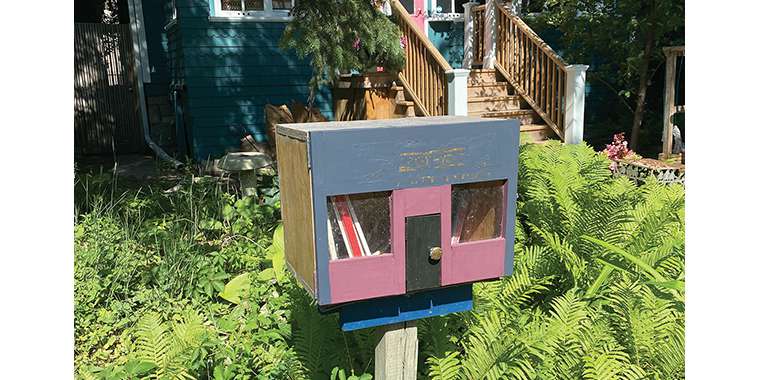Who would have thought a pole-mounted wooden box made from an old garage door would create a little library revolution?
It was 2009 in Wisconsin, U.S. when 51-year-old Todd Bol used some repurposed lumber to create the shape of a one-room schoolhouse, filled it with books and mounted it on his front lawn as a tribute to his mother, a school teacher who loved books. The idea quickly spread and in 2012, the Little Free Library nonprofit organization was incorporated.
Today, the premise of “take a book, return a book” has grown to well over 150,000 registered Little Free Libraries spread across 120 countries with over 300 million books shared! But there could be countless more because you don’t have to register to host one.
If you’re looking for something to do this Canada Day, why not create a little free library of your own? It’s a fun project for the whole family, a great way to connect with your neighbours, and ties people together over common interests.
So, what do you need to know about creating one that your neighbours will love? Here are some points to consider.
Building your little library
You can start from scratch, find internet plans, or purchase a kit, so there’s an option for anyone who wants to be a “Little” librarian. You can even adapt other structures like birdhouses, rabbit hutches, old appliances, or old newspaper stands to serve as your book depot.
The most important element of construction, though, is weatherproofing, especially against water. Moisture is the biggest threat to your collection, so not only must your box be tightly constructed, seams must be sealed, inside and out.
If you live in a climate where snow piles up, check out tips on winterizing a Little Free Library. Try using exterior house paint and primer, and building a structure with a sloped roof so snow doesn’t pile up. Propping your books up on a silicone mat will also help protect them in the event water does get in, so they won’t be sitting in a puddle. The door is essential for keeping out the elements. Consider a structure with an overhang over the door so it’s more protected.
In terms of size, aim for a book space that’s about 50 cm wide by 40 cm deep and 45 cm high. That should provide room to fit about 20-25 books. If you’re looking to build a library to share with many, you might opt for a larger structure, but keep in mind a larger structure could require a permit.
Once you consider these fundamentals, the sky’s the limit as far as design and customization.
Location
Your little library needs to be accessible without intruding on your property — you probably don’t want people coming up to your front porch to peruse your collection. Curbside is the classic spot, but you may need to alter that if you live on a busy street with parking restrictions. Think about how your little library traffic might inconvenience both you, your neighbours, and traffic (foot, bike, or vehicle).
If you’re building a pole-mounted library, the mounting post must be solid. To install your post, you may need a permit and to mark utility locations. The process for this varies by community. There likely aren’t many restrictions to what you can place on your own property, but there may be rules on construction methods. Before you build anything, be sure to check your municipality’s regulations.
If your municipality allows for it, see if you can add a little library to a local park with plenty of benches where people can sit and relax. You’ll add something special to the neighbourhood and maybe even start to meet some new faces as you frequent the library.
Stocking the shelves
Curation is up to you! If your aim is to declutter your own shelves, a little library is a good way to dispense with those titles you no longer treasure. Your neighbours likely represent a broad audience, so mix it up. Fiction, non-fiction, how-tos, biographies and children’s books make a good start. You can even add magazines and newspapers — many teachers use these for arts and crafts and would be happy to take them off your hands.
Getting everyone involved
You’ll likely raise the curiosity of people new to the little free library concept, so it’s a good idea to make a sign explaining your intentions. Downsizers might emphasize the taking of books, but most who are putting the effort into their library want to see sustained use, so they’ll encourage leaving books as well as borrowing.
It may also be a good idea to inform your close neighbours of your plans and see if they have any concerns. It’s just common courtesy to let people know when you’re doing something that might disrupt the natural routine of the neighbourhood. Plus, you may find others are interested in contributing or setting one up, too, making it a community effort rather than a solo one.
Create interest for your little library by posting ads on community boards, both virtual and real world. A cute spot and a great selection will generate word of mouth advertising, which can attract a wide range of titles, topics and authors!
There’s also a Little Free Library app for registered libraries that lets you know which ones are near you, create routes to visit ones in your area, and favourite the ones where you have success. It’s a whole world of reading wonder, and it can happen right in your community.
Your library may run itself in terms of titles, though a little maintenance will encourage your readers to return. Keep the library and its surroundings accessible and tidy and restack books as needed to prevent overcrowding. Just as every neighbourhood has its personality, so too will your little library, spreading a bit of family-friendly fun for everyone.
You can register your little free library at littlefreelibrary.org or visit wpl.winnipeg.ca for a map on where to find a little free library near you.
— Realtor.ca



